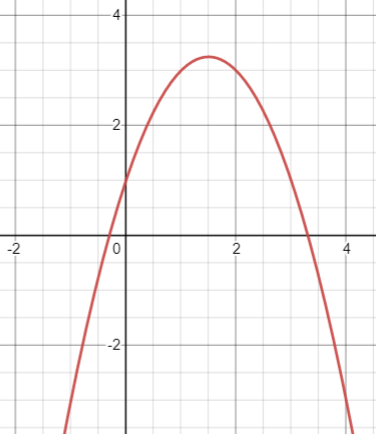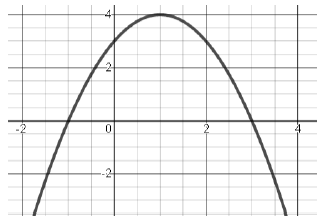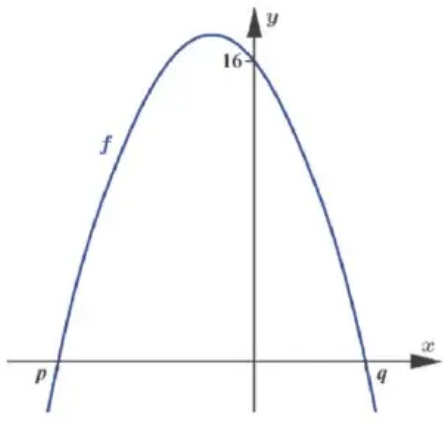PROBLEMS INVOLVING QUADRATIC FUNCTIONS
The equation which is in the form
f(x) = ax2 + bx + c
is known as quadratic equation.
The graphical form of quadratic function is parabola. Based on the signs of a, we can say the parabola opens upward or downward.
- If sign of a is +, then the parabola opens upward.
- If sign of a is -, then the parabola opens downward.
Equation of parabola can be converted into three different forms.
- Standard form
- Vertex form
- Factored form.
How to convert into standard form ?
Example :
Write y = 2(x+1)2 + 4 in standard form.
Solution :
y = 2(x+1)2 + 4
Using the formula (a + b)2, we get
y = 2(x2 + 2x + 1) + 4
y = 2x2 + 4x + 2 + 4
y = 2x2 + 4x + 6
How to convert into vertex form ?
Example :
Convert y = x2 + 4x - 3 into vertex form.
Solution :
y = x2 + 4x - 3
y = x2 + 2 ⋅ x ⋅ 2 + 22 - 22 - 3
y = (x+2)2 - 4 - 3
y = (x+2)2 - 7
By converting the equation with vertex form, we can find vertex (h, k)
How to convert into factored form ?
Example :
Convert y = x2 - 4x + 3 into factored form.
Solution :
y = x2 - 4x + 3
y = x2 - 1x - 3x + 3
y = x(x - 1) -3(x - 1)
y = (x-1)(x - 3)
By applying x = 0, we will get y-intercept and by applying y = 0, we will get x-intercept.
Problem 1 :
Which of the following gives the solution set for the polynomial equation below?
x2−11𝑥+19 = −5
A. {-3, -8} B. {3, 8} C. {-3, 8} D. {3, -8}
Solution :
x2−11𝑥+19 = −5
Add 5 on both sides.
x2−11𝑥+19+5 = 0
x2−11𝑥+24 = 0
(x - 3) (x - 8) = 0
Equating each factors to zero, we get
x = 3 and x = 8
So, the solution set is {-8, 3}
Problem 2 :
Which of the following could be the equation for the polynomial function below?

A. y = −x2+3x+1 B. y = x2−0.25x+3.25
C. y = x2−x+3 D. y=−x2+0.25x−3.25
Solution :
From the graph, the parabola opens down. So, we can clearly reject options B and C.
Option (A) :
𝑦 = −x2+3x+1
Converting into vertex form, we get
h = 3/2 and k = 13/4
From the graph, the vertex in between 2 and 4. So, option A is correct.
Problem 3 :
Which of the following is an equation for the function below and gives the coordinates of the vertex as constants or coefficients?

A. y = −(x−3)(x+1) B. y = −x2+2x+3
C. y = (x+1)2+4 D. y = −(x−1)2+4
Solution :
y = −(x−3)(x+1)
Equating each factor to zero, we get
x = 3 and x = -1
By observing the graph given above, it opens downward and x-intercepts are 3 and -1.
Finding vertex :
y = −(x−3)(x+1)
y = −(x2-3x+1x−3)
y = −(x2-2x−3)
y = −(x2 - 2⋅x⋅1 + 12 -12 − 3)
y = −[(x-1)2 - 4]
y = −(x-1)2 + 4
Vertex is (1, 4).
So, option A is correct.
Problem 4 :
How many solutions are there to the following system of equations?
y = −(1/2)x2+7 and 𝑦 = −2x2+5
A. 0 B. 1 C. 2 D. 3
Solution :
y = −(1/2)x2+7 ------(1) y = −2x2+5 ------(2)
To find the points of intersection, we can solve (1) and (2).
(1) = (2)
−(1/2)x2+7 = −2x2+5
-x2 + 14 = -4x2 + 10
3x2 = -10 - 14
3x2 = -24
x2 = -8
x = √-8
It is not real number, so it will not have solution. So, zero solution is the answer.
Problem 5 :
a) Use x-intercepts to find the axis of symmetry of y = (x + 2)(x - 5)
b) Check your answer to a. by writing the function in the form y = ax2 + bx + c and then evalauting -b/2a.
Solution :
a)
y = (x + 2)(x - 5)
Midpoing of x-intercepts = axis of symmetry
x + 2 = 0 and x - 5 = 0
x = -2 and x = 5
Midpoing of x-intercepts = (-2 + 5)/2
x = 3/2
b)
y = (x + 2)(x - 5)
y = x2 - 5x + 2x - 10
= x2 - 3x - 10
Comparing with y = ax2 + bx + c, we get a = 1, b = -3 and c = -10
x = -b/2a
x = -(-3)/2(1)
x = 3/2
In both ways, we get the same answer.
Problem 6 :
Let p(x) = a(x + 4)(x - 2) the following diagram shows part of the graph of f.

a) Write down the value of p and q.
b) Show that a = -2
c) Find the equation of the axis of symmetery of the graph of f.
d) Locate the axis of symmetry on the graph.
e) Calculate the maximum value of f.
f) Write the equation in vertex form.
Solution :
a) Here p and q are x-intercepts.
p(x) = 0
a(x + 4)(x - 2) = 0
x + 4 = 0 and x = -4
x - 2 = 0 and x = 2
the value of p is -4 and q is 2.
b) The parabola passes through (0, 16).
p(x) = a(x + 4)(x - 2)
Applying the point, we get
p(0) = a(0 + 4)(0 - 2)
16 = a(4)(-2)
-8a = 16
a = -2
c) Equation of axis of symmetery = (-4 + 2)/2
= -2/2
So, the axis of symmetry is x = -1.
d) At x = -1
e) y = -2(-1 + 4)(-1 - 2)
y = -2(3)(-3)
y = 18
f) p(x) = -2(x + 4)(x - 2)
= -2[x2 - 2x + 4x - 8]
= -2[x2 + 2x - 8]
= -2x2 - 4x + 16
-2(x2 - 2x + 8)
= -2[(x - 1)2 - 1 + 8]
= -2[(x - 1)2 + 7]
y = -2(x - 1)2 - 14
Recent Articles
-
Finding Range of Values Inequality Problems
May 21, 24 08:51 PM
Finding Range of Values Inequality Problems -
Solving Two Step Inequality Word Problems
May 21, 24 08:51 AM
Solving Two Step Inequality Word Problems -
Exponential Function Context and Data Modeling
May 20, 24 10:45 PM
Exponential Function Context and Data Modeling